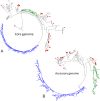Diversity and Population Overlap between Avian and Human Escherichia coli Belonging to Sequence Type 95
- PMID: 30651401
- PMCID: PMC6336079
- DOI: 10.1128/mSphere.00333-18
Diversity and Population Overlap between Avian and Human Escherichia coli Belonging to Sequence Type 95
Abstract
Avian-pathogenic Escherichia coli (APEC) is a subgroup of extraintestinal pathogenic E.coli (ExPEC) presumed to be zoonotic and to represent an external reservoir for extraintestinal infections in humans, including uropathogenic E. coli (UPEC) causing urinary tract infections. Comparative genomics has previously been applied to investigate whether APEC and human ExPEC are distinct entities. Even so, whole-genome-based studies are limited, and large-scale comparisons focused on single sequence types (STs) are not available yet. In this study, comparative genomic analysis was performed on 323 APEC and human ExPEC genomes belonging to sequence type 95 (ST95) to investigate whether APEC and human ExPEC are distinct entities. Our study showed that APEC of ST95 did not constitute a unique ExPEC branch and was genetically diverse. A large genetic overlap between APEC and certain human ExPEC was observed, with APEC located on multiple branches together with closely related human ExPEC, including nearly identical APEC and human ExPEC. These results illustrate that certain ExPEC clones may indeed have the potential to cause infection in both poultry and humans. Previously described ExPEC-associated genes were found to be encoded on ColV plasmids. These virulence-associated plasmids seem to be crucial for ExPEC strains to cause avian colibacillosis and are strongly associated with strains of the mixed APEC/human ExPEC clusters. The phylogenetic analysis revealed two distinct branches consisting of exclusively closely related human ExPEC which did not carry the virulence-associated plasmids, emphasizing a lower avian virulence potential of human ExPEC in relation to an avian host.IMPORTANCE APEC causes a range of infections in poultry, collectively called colibacillosis, and is the leading cause of mortality and is associated with major economic significance in the poultry industry. A growing number of studies have suggested APEC as an external reservoir of human ExPEC, including UPEC, which is a reservoir. ExPEC belonging to ST95 is considered one of the most important pathogens in both poultry and humans. This study is the first in-depth whole-genome-based comparison of ST95 E. coli which investigates both the core genomes as well as the accessory genomes of avian and human ExPEC. We demonstrated that multiple lineages of ExPEC belonging to ST95 exist, of which the majority may cause infection in humans, while only part of the ST95 cluster seem to be avian pathogenic. These findings further support the idea that urinary tract infections may be a zoonotic infection.
Keywords: E. coli; genomics; pathogenicity; sequencing; zoonosis.
Copyright © 2019 Jørgensen et al.
Figures


Similar articles
-
Avian pathogenic, uropathogenic, and newborn meningitis-causing Escherichia coli: how closely related are they?Int J Med Microbiol. 2007 Jun;297(3):163-76. doi: 10.1016/j.ijmm.2007.01.003. Epub 2007 Mar 19. Int J Med Microbiol. 2007. PMID: 17374506
-
Extraintestinal pathogenic Escherichia coli O1:K1:H7/NM from human and avian origin: detection of clonal groups B2 ST95 and D ST59 with different host distribution.BMC Microbiol. 2009 Jul 7;9:132. doi: 10.1186/1471-2180-9-132. BMC Microbiol. 2009. PMID: 19583828 Free PMC article.
-
Poultry-origin extraintestinal Escherichia coli strains carrying the traits associated with urinary tract infection, sepsis, meningitis and avian colibacillosis in India.J Appl Microbiol. 2021 Jun;130(6):2087-2101. doi: 10.1111/jam.14905. Epub 2020 Nov 10. J Appl Microbiol. 2021. PMID: 33095966
-
Global Extraintestinal Pathogenic Escherichia coli (ExPEC) Lineages.Clin Microbiol Rev. 2019 Jun 12;32(3):e00135-18. doi: 10.1128/CMR.00135-18. Print 2019 Jun 19. Clin Microbiol Rev. 2019. PMID: 31189557 Free PMC article.
-
Escherichia coli and urinary tract infections: the role of poultry-meat.Clin Microbiol Infect. 2016 Feb;22(2):122-129. doi: 10.1016/j.cmi.2015.11.010. Epub 2015 Dec 8. Clin Microbiol Infect. 2016. PMID: 26679924 Review.
Cited by
-
Molecular characterization of avian pathogenic Escherichia coli from broiler chickens with colibacillosis.Poult Sci. 2020 Feb;99(2):1088-1095. doi: 10.1016/j.psj.2019.10.047. Epub 2019 Nov 22. Poult Sci. 2020. PMID: 32029145 Free PMC article.
-
Genomics Analysis to Identify Multiple Genetic Determinants That Drive the Global Transmission of the Pandemic ST95 Lineage of Extraintestinal Pathogenic Escherichia coli (ExPEC).Pathogens. 2022 Dec 7;11(12):1489. doi: 10.3390/pathogens11121489. Pathogens. 2022. PMID: 36558824 Free PMC article.
-
Distinguishing Pathovars from Nonpathovars: Escherichia coli.Microbiol Spectr. 2020 Dec;8(4):10.1128/microbiolspec.ame-0014-2020. doi: 10.1128/microbiolspec.AME-0014-2020. Microbiol Spectr. 2020. PMID: 33385193 Free PMC article. Review.
-
Phylogenetic relationship and virulence gene profiles of avian pathogenic and uropathogenic Escherichia coli isolated from avian colibacillosis and human urinary tract infections (UTIs).Iran J Vet Res. 2021 Summer;22(3):203-208. doi: 10.22099/ijvr.2021.40081.5810. Iran J Vet Res. 2021. PMID: 34777520 Free PMC article.
-
Antibiotic resistance, virulence, and phylogenetic analysis of Escherichia coli strains isolated from free-living birds in human habitats.PLoS One. 2022 Jan 12;17(1):e0262236. doi: 10.1371/journal.pone.0262236. eCollection 2022. PLoS One. 2022. PMID: 35020771 Free PMC article.
References
-
- Dho-Moulin M, Fairbrother JM. 1999. Avian pathogenic Escherichia coli. Vet Res 30:299–316. - PubMed
Publication types
MeSH terms
LinkOut - more resources
Full Text Sources
Medical

